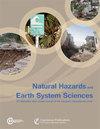气候引发的风暴将导致未来南海地区风暴潮风险大幅增加
IF 4.7
2区 地球科学
Q1 GEOSCIENCES, MULTIDISCIPLINARY
引用次数: 0
摘要
摘要由极端海平面引起的沿海洪水是最危险的自然灾害之一。风险最高的是那些生活在低洼沿海地区的人,他们面临着热带气旋带来的风暴潮。在这里,我们应用了一个新的模型框架来估计中国南部、越南、柬埔寨、泰国和马来西亚沿海地区过去和/或现在和未来风暴潮水位和极端海平面的概率。配置一个区域水动力模式来模拟1万年的合成热带气旋活动,代表过去/现在(1980-2017)和未来高排放情景(2015-2050)时期。结果表明,由于强烈热带气旋频率的增加,极端风暴潮和总水位将在未来几十年大幅增加。中国南部和越南北部和南部海岸线的风暴潮增加了1米,明显大于同期平均海平面上升的预期变化。到2050年,目前暴露在2.5米或更高风暴潮水位下的海岸线长度将增加一倍以上。由于热带气旋路径向南移动,柬埔寨、泰国和马来西亚的海岸线部分地区预计将在未来经历以前从未见过的风暴潮(在更高的返回期)。鉴于这些发现,应该审查这些地区的沿海洪水管理和适应能力,以评估它们对未来极端海平面的抵御能力。本文章由计算机程序翻译,如有差异,请以英文原文为准。
Climate-induced storminess forces major increases in future storm surge hazard in the South China Sea region
Abstract. Coastal floods, driven by extreme sea levels, are one of the most dangerous
natural hazards. The people at highest risk are those living in low-lying
coastal areas exposed to tropical-cyclone-forced storm surges. Here we
apply a novel modelling framework to estimate past and/or present and future storm-surge-level and extreme-sea-level probabilities along the coastlines of southern
China, Vietnam, Cambodia, Thailand, and Malaysia. A regional hydrodynamic
model is configured to simulate 10 000 years of synthetic tropical cyclone
activity, representative of a past/present (1980–2017) and high-emission-scenario future (2015–2050) period. Results show that extreme storm surges, and therefore total water levels, will increase substantially in the coming decades, driven by an increase in the frequency of intense tropical
cyclones. Storm surges along the southern Chinese and northern and southern Vietnamese
coastlines increase by up to 1 m, significantly larger than expected changes in mean sea-level rise over the same period. The length of coastline that is presently exposed to storm surge levels of 2.5 m or greater will more than double by 2050. Sections of Cambodian, Thai, and Malaysian coastlines are projected to experience storm surges (at higher return periods) in the
future, not previously seen, due to a southward shift in tropical cyclone
tracks. Given these findings, coastal flood management and adaptation in
these areas should be reviewed for their resilience against future extreme
sea levels.
求助全文
通过发布文献求助,成功后即可免费获取论文全文。
去求助
来源期刊
CiteScore
7.60
自引率
6.50%
发文量
192
审稿时长
3.8 months
期刊介绍:
Natural Hazards and Earth System Sciences (NHESS) is an interdisciplinary and international journal dedicated to the public discussion and open-access publication of high-quality studies and original research on natural hazards and their consequences. Embracing a holistic Earth system science approach, NHESS serves a wide and diverse community of research scientists, practitioners, and decision makers concerned with detection of natural hazards, monitoring and modelling, vulnerability and risk assessment, and the design and implementation of mitigation and adaptation strategies, including economical, societal, and educational aspects.

 求助内容:
求助内容: 应助结果提醒方式:
应助结果提醒方式:


